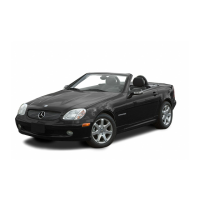
Do you have a question about the Mercedes-Benz SLK 230 and is the answer not in the manual?
| Brand | Mercedes-Benz |
|---|---|
| Model | SLK 230 |
| Category | Automobile |
| Language | English |
Provides essential information for vehicle operation and safe driving.
Details warranties covering the vehicle, including limited and emission warranties.
Recommends using genuine Mercedes-Benz parts for optimal reliability and safety.
Outlines California lemon law rights regarding substantial defects and repair attempts.
Explains various symbols used in the manual to denote warnings, hazards, and helpful information.
Crucial safety guidelines for proper vehicle use and handling to prevent accidents or injury.
Overview of vehicle controls accessible from the driver's seat.
Explains gauges, indicators, and warning lamps within the instrument panel.
Details controls located on the upper and lower sections of the center console.
Identifies components and controls within the overhead console.
Instructions on how to unlock the vehicle using the remote control or key.
Guidance on adjusting seats, steering wheel, and mirrors for optimal comfort and safety.
Essential information for initial driving, including seat belt use and basic driving procedures.
Procedures for safely parking the vehicle and engaging the parking brake and locks.
Information on restraint systems, including seat belts, airbags, and child seat safety.
How to activate and deactivate the vehicle's panic alarm system.
Explains systems like ABS, BAS, and ESP that enhance vehicle control and safety.
Details on the immobilizer, anti-theft alarm, and tow-away alarm features.
Comprehensive guide to locking and unlocking doors, trunk, and fuel filler flap with keys and remote.
Instructions for removing/installing head restraints and adjusting seats manually or electrically.
Operation of exterior lamps, including headlamps, fog lamps, and turn signals.
Information on instrument illumination, gauges, and indicators.
Procedures for operating the manual transmission, including shifting and reverse.
Guide to using the automatic transmission, including gear selection and program modes.
Information on windshield wipers, headlamp cleaning, and rear view mirrors for clear visibility.
Operation of the climate control system for heating, cooling, and air distribution.
Details on operating the radio, cassette, CD player, and telephone functions.
Instructions for operating power windows, including express open/close and synchronization.
Procedures for opening and closing the retractable hardtop for safe operation.
Explanation of driving assistance systems like cruise control and their operation.
Information on interior storage, cup holders, and other convenience features.
Guidelines for breaking in the vehicle to ensure optimal performance and longevity.
Advice on fuel-efficient driving, pedal use, brakes, and driving off.
Procedures for refueling, checking fluid levels, and general vehicle checks.
Instructions for opening the hood, checking engine oil, coolant, and battery.
Information on tire care, rotation, inflation pressure, and wheel specifications.
Recommendations for winterizing the vehicle, using winter tires, and driving in snow or ice.
Information on the flexible service system (FSS) and clearing the service indicator.
Guidance on cleaning and caring for the vehicle's exterior and interior surfaces.
Troubleshooting common vehicle problems indicated by dashboard warning lamps.
Location of essential items like the first aid kit, tool kit, jack, and spare tire.
Procedures for unlocking and locking the vehicle, trunk, and transmission selector lever in emergencies.
Step-by-step instructions for replacing various exterior and interior light bulbs.
Guidance on removing and replacing wiper blades and their inserts.
Instructions on using the TIREFIT kit or spare wheel for emergency tire repair.
Safety precautions and procedures for handling, disconnecting, and reconnecting the vehicle battery.
Steps for safely jump-starting a vehicle with a discharged battery using jumper cables.
Recommendations and procedures for safely towing the vehicle using appropriate equipment.
Location and procedure for accessing the main and auxiliary fuse boxes.
Information on obtaining genuine Mercedes-Benz parts and their quality standards.
Overview of vehicle warranties, including limited, emission, and service information booklet details.
Location of certification, vehicle identification, engine, and emission control labels.
Diagrams showing the routing of the poly-V-belt drive for different engine models.
Technical specifications for engine models, including bore, stroke, and output.
Guidelines on using approved tires and rims, and information on tire quality grading.
Technical data for the vehicle's electrical components like generator, starter motor, and battery.
Specifications for vehicle dimensions, including length, width, height, and wheelbase.
Information on vehicle weight limits, such as maximum trunk load.
Capacities and types of fuels, coolants, and lubricants recommended for the vehicle.
Details on uniform tire quality grading, including treadwear, traction, and temperature ratings.
Definition of ABS and its function in preventing wheel lock-up during braking.
Explanation of the alignment bolt used for wheel alignment during tire changes.
How the system deactivates the passenger front airbag when a compatible child seat is installed.
Special restraint systems designed for children that work with the vehicle's airbag system.
Definition of BAS and its role in reducing braking distances during emergency situations.
Information about the Mercedes-Benz customer service center for vehicle assistance.
Explanation of the data bus network controlling various vehicle functions.
Definition of the cockpit referring to all controls and displays in the driver's field of vision.
Description of a compact spare tire that requires inflation before use for temporary repair.
Definition of the cruise control system for maintaining a set vehicle speed automatically.










